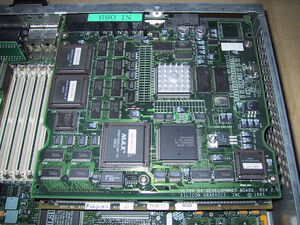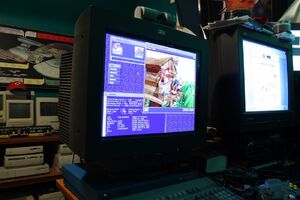The Indy, code-named "Guinness", is a low-end workstation introduced on 12 July 1993.[1] Developed and manufactured by Silicon Graphics Incorporated (SGI), it was the result of their attempt to obtain a share of the low-end computer-aided design (CAD) market, which was dominated at the time by other workstation vendors; and the desktop publishing and multimedia markets, which were mostly dominated at the time by Apple Computer. It was discontinued on 30 June 1997, with support to end on 31 December 2012.[.[2]
Overview[]

The Indy packed a reasonable amount of power into a very small (41 cm × 36 cm × 8 cm), simple, and elegant package. The sturdy, electric-blue colored "pizza box" chassis is comparable to a small desktop PC from the same era, and is designed to fit underneath a large CRT monitor. It was the first computer to include a digital video camera, and was built with a (then) forward-looking architecture including an on-board ISDN adapter. With the inclusion of analog and digital I/O, SCSI, and standard composite and S-Video inputs, the Indy was a machine designed for multimedia.
At the beginning of its life, the Indy came standard with 16MB of RAM. IRIX 5.1, the first operating system for the Indy, did not take full advantage of the hardware due to inadequate memory management. SGI realized this and quickly increased the base specification to 32 MB, at considerable cost. Subsequent IRIX releases made huge improvements in memory usage. The latest release of IRIX available for the Indy workstations is 6.5.22.
One option for the Indy was a floptical drive. The floptical used 21 MB disks, but was able to read and write standard magnetic floppies as well.
CPU[]

The Nintendo 64 SGI Indy internal board.
Indy's motherboard has a socket for the Processor Module (PM). Early Indys used a 100 MHz MIPS R4000PC microprocessor, which quickly proved inadequate. The Indy, at the bottom of SGI's price list, was then upgraded with the MIPS R4400 and the low-cost, low-power-consumption Quantum Effect Devices (QED) R4600. The R4600 had impressive integer performance, but had poor floating-point capability. This, however, wasn't too large of a problem in a system that was generally not designed for floating-point-intensive applications. For this reason, the R4600 made an appearance outside the Indy line just once, and only briefly, in the SGI Indigo². This series of microprocessor issues, along with the relatively low-powered graphics boards, lower maximum RAM amount, and relative lack of internal expansion ability compared to the SGI Indigo led to the Indy being pejoratively described amongst industry insiders as "An Indigo without the 'go'."
As the R4600 chip itself has no L2 cache controller, an external controller was used to add 512K of L2 cache. R4600s processor modules, both with an L2 cache (SC) and without (PC), are common in the Indy. At the same clock rate, the SC version of the processor module is generally 20 to 40 percent faster than the PC version, due to the memory cache.
The Indy was also the first SGI machine to utilize the QED R5000 microprocessor, which offered significant advantages over the R4400 and R4600 it replaced.
Graphics[]

A running SGI Indy with Nintendo 64 dev. environment.
Three graphics subsystems were available for the Indy: 8-bit XL, 24-bit XL, and 24-bit XZ. Each supported a maximum resolution of 1280 × 1024 at a refresh rate of 76 Hz, and had a 13W3 monitor connection. Graphics options were connected to the system using a GIO32bis bus.
8-bit XL Also known as Newport graphics based on the REX3 chipset, these were designed for general 2D X11 applications; no hardware 3D acceleration was included. This was the first accelerator to demonstrate object-based antialiasing and sub-pixel exact Bresenham lines. These worked best for 2D CAD or general office use.
24-bit XL (XGE) Using an identical circuit board as the 8-bit XL, the 24-bit XL included three times as much framebuffer memory to accommodate 24-bit color. A popular choice for some general graphics work, since its 2D performance is better than the XZ card.
In an Indy with an R5000 CPU, these graphics options are called XGE, because an R5000 CPU can perform 3D geometry calculations faster than the XZ subsystems's four Geometry Engines--as a result, all 3D is done in software. The situation is, however, reversed when the calculations are done for full-screen rendering and involve z-buffer operations (which XL does not possess). XZ graphics were rarely paired with the R5000 for this reason.
XZ These graphics were a port of the Indigo²'s XZ (Elan) graphics into Indy - they offered very good non-textured 3D performance at the time, sacrificing a bit of 2D performance in return. The XZ graphics option was not widely used in Indy systems that used the R5000 CPU. This was mostly due to extensions of the MIPS instruction set that were implemented in the R5000. With the new instructions, the R5000 CPU could perform coordinate transformations faster than the XZ graphics board. However, using XZ to perform coordinate transforms does free the CPU to perform other rendering-related calculations. If the application is not transform-limited (i.e. limited by the speed of coordinate transformation), then the XZ option can provide significant rasterization performance advantages over the XL boards. These graphics take the form of two boards, one on top of the other, and block both GIO option slots, making them less favorable since options such as 10/100 Ethernet and JPEG compression boards cannot be installed.
Video[]
The Indy was the first SGI to have video inputs by default. Each and every Indy has a composite, S-Video, and digital video input built into the motherboard, which collectively are known as "Vino" (video input, no output) video. None of them are of professional quality, but are still usable. The digital input is a proprietary D-sub connector with a rectangular array of pins, and is used by the SGI IndyCam. The connector is the same as serial ports on Cisco routers, however is electrically different.
The maximum supported input resolution is 640x480 (NTSC) or 768x576 (PAL). It takes a fast machine to capture at either of these resolutions, though; an Indy with slower R4600PC CPU, for example, may require the input resolution to be reduced before storage or processing. However, the Vino hardware is capable of DMAing video fields directly into the framebuffer with minimal CPU overhead.
None of the Indys support a video output by default - that would require the Indy Video GIO32 card. On top of that, there is an optional module called CosmoCompress, which offers on-the-fly JPEG video compression and decompression and uses up another GIO32 slot.
Drives[]
The Indy has two drive bays for 1-inch tall 3.5" drives. The upper drive bay is externally accessible and may hold a SCSI floptical drive. All external and internal drives share a single Fast SCSI bus (unless a GIO32 SCSI card has been installed).
External CD-ROM drive connect via SCSI connector at rear side of the box. Typical drive supports boot, OS install, audio. Special ROM is required to boot from for certain device types. A small number of CD-ROM drives have the firmware needed to do audio over SCSI.
Networking[]
All Indys shipped with AUI/10BASE-T Ethernet and ISDN as standard equipment. The Ethernet ports are half-duplex only. The 10BaseT port takes precedence over the AUI port - if the system detects a carrier on both ports, it will use the 10Base-T.
Two different manufacturers produced 100BASE-TX Ethernet cards compatible with the Indy, both of which attached to the system using the GIO32 bus. Set Engineering produced one such fast Ethernet card, based on the Texas Instruments ThunderLAN chipset, under contract with SGI. Phobos also produced models of fast Ethernet cards for the Indy (the G100 and G130).
The ISDN port provided on the Indy has no NT1. An external NT1 is required to use the ISDN port in North America.
Power Failure[]
The component of the Indy most prone to failure is the Nidec/Power General power supply. New power supplies are manufactured by Sony and sold through resellers; however, they are expensive.
The Indy's Ethernet address, which doubles as the system's serial number, is stored in battery-backed RAM. This means that when the internal battery dies, so does the system—it will hang at the PROM monitor and refuse to boot any further as a result of the Ethernet address being reset to FF:FF:FF:FF:FF:FF (expressed in hexadecimal). A competent user can replace the PROM battery and reprogram it. The original battery was made by Dallas Semiconductor, now a division of Maxim Integrated Products. The original unit was marked the "DS-1386-8K-150"; however, its replacement unit, the "DS-1386-8K-120," can be directly substituted with no ill effects.
One can set a new MAC address from the Command Monitor with the command "setenv -f eaddr xx:xx:xx:xx:xx:xx". The -f switch here will force the new MAC address. The MAC address is (usually) on a sticker to the rear of the unit, and hence can be reprogrammed without losing software licences, which often rely on it to verify ownership. Otherwise, any MAC address in SGI's block is usable.
Specifications[]
| Specifications | |||
| Manufacturer: | SGI | Graphics: | 24-bit XL |
| Introduced: | 1993 | Storage: | SCSI |
| End of line: | 1997 | Ports: | SCSI, ISDN, 13w3, ethernet, serial, parallel |
| Price: | ? | OS: | IRIX |
| CPU: | R4000 or R5000 | Size: | 41(W) x 8(H)x 36(D) cm |
| RAM: | 16 - 256MB | Weight: | 7 kg |